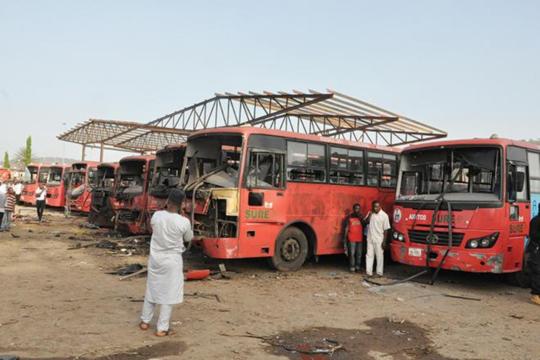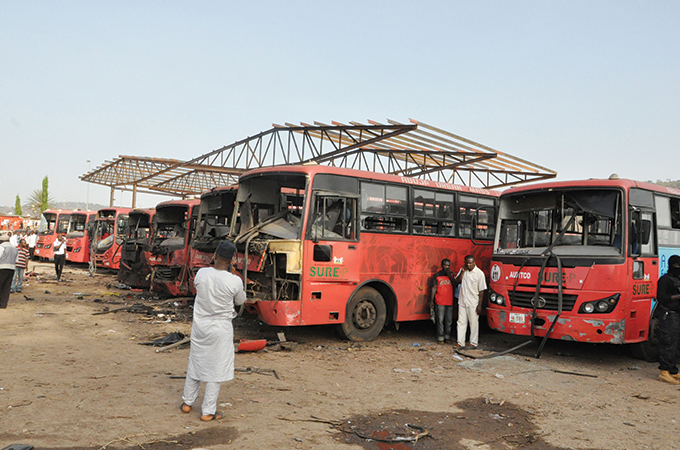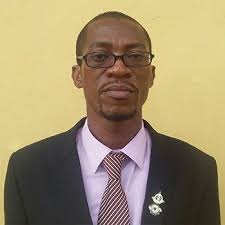
 |
| Onlookers inspect damaged buses following an explosion at a bus park in Abuja, Nigeria [AP Photo/Gbemiga Olamikan] |
| Abstract On 14 April 2014, a bomb-laden vehicle exploded at a crowded bus park in Nyanya, a suburb of Abuja, killing 71 people and injuring 124 others. The leader of Nigeria’s Boko Haram, Abubakar Shekau, claimed responsibility for the bombing. This report briefly examines the Nyanya bombing, with emphasis on some key considerations that informed the attack on the bus terminal. To be able to degrade Boko Haram’s operational capability in a sustainable manner, the Nigerian government needs to urgently implement a robust strategy targeted at decimating the tripod of terrorist sustainability – ideology, recruitment and funding |
Introduction
The first quarter of year 2014 has witnessed tremendous escalation in attacks mounted by the Boko Haram in Nigeria. Since 2009, the Islamist group has been waging a campaign of violence to impose Shariah, or Islamic law, in Nigeria. (1) Most of its attacks in recent months had concentrated in the group’s remote north-eastern stronghold – Adamawa, Borno and Yobe States – where the military is waging a nearly one year offensive. Within the first four months of 2014, for instance, over 2,596 people have been killed in terror-related attacks in Nigeria. Of the total deaths from attacks by Boko Haram in the first quarter of the year, about 1,262 persons were killed in Borno State, while not less than 177 persons were killed in Adamawa State. (2)
On 14 April 2014, however, the group brought its violent campaign very close to Nigeria’s seat of power, when it detonated a bomb-laden vehicle at a crowded bus park in Nyanya, a suburb of Abuja, killing 71 people and injuring 124 others, according to official estimates. Boko Haram leader, Abubakar Shekau, claimed responsibility for the deadly attack, in a 28-minute video obtained by Agence France-Presse. This report briefly examines the Nyanya bombing, with emphasis on some key considerations that informed the attack on the bus terminal.
The 14 April Nyanya Bombing
The Nyanya bomb blast, which analysts now refer to as the 14/4 bombing, is so far the deadliest attack on the nation’s capital, ever since a 35-year-old Boko Haram member, Mohammad Manga, detonated his bomb-laden vehicle at Police Headquarters, Abuja, on 16 June 2011. The 14/4 bombing ripped a hole of about 1.2m in the ground of Nyanya Motor Park, located close to the foot of a bridge, about 8 km south of Abuja. (3) The early morning blast caused secondary explosions as fuel tanks of cars parked nearby ignited and burned. Over 40 vehicles were destroyed from the effect of the blast, comprising of 16 large “El-Rufai Buses” (4) and 24 other cars and mini-buses. Also several commercial motorcycles were burnt beyond recognition.
As one reporter graphically described the incident, “by the time the fire was put out, scores of badly burnt severed arms, legs, heads, flesh and other parts of human beings littered the ground of a large expanse of land…the majority of whom were on their way to their workplaces”. (5) Although government officials claimed that 71 people were killed and 124 others injured, most media reported that over 89 lives were lost, while 257 others sustained various degrees of injuries. (6) Shortly after the blast, the videos and pictures of the incident went viral on the internet apparently posted by individuals who had taken shots of the blast.
Two contending accounts of how the blast occurred was reported. The first version, by some survivors, claimed that a vehicle was driven into the park early that morning and parked in front of the already loaded high capacity buses. The explosion went off shortly after the driver disappeared, pretending as if he had gone to get a lower denomination to settle passengers he brought to the park. The second account, which emerged four days later, claimed that the car containing the bomb was driven to the park by two men in military uniform a day before the incident. They parked the car and left in another car around 2am, before the explosion occurred about four hours later. (7) Irrespective of which version emerges as authentic, it is obvious that the blast was caused by remotely controlled improvised explosive device (IED) laden in a vehicle. Why was the Nyanya bus terminal the target of attack?
Some Considerations that Informed the 14/4 bombing
From an analytical point of view, at least four critical interrelated considerations may have informed the 14/4 bombing. These considerations that will be subsequently discussed include the nature of target, location, timing, and strategic intent.
Nature of Target: The desire to pick out a soft target that could be easily hit with a high success rate in terms of death toll and destruction must have figured prominently in Boko Haram’s calculation. Familiarity with most of the ‘soft targets’ in Abuja such as hotels, schools, motor parks, markets, churches, and recreational parks, reveals that public motor parks are the least secure. Following cases of bombing in Nigeria since 2011, most soft targets like churches, markets, schools, and hotels in Abuja, have hardened protective security measures through the stationing of security personnel, access restriction and enhanced screening of visitors. The same cannot be said of motor parks, especially those being used by government-operated transport system. The target is even more attractive given that the government operated public mass transit system, popularly known as “El-Rufa’i Buses”, has witnessed increased patronage by commuters, following the June 2013 banning of mini commercial buses popularly known in Abuja as “Araba” from operating in the city centre. This made the El-Rufa’i Buses terminal (park) in Nyanya a terrorist choice target.
Location of the Target: While the location of a terror-orchestrated bombing could be anywhere, terror strategists are known to prefer a high capacity venue. Indeed, there are several motor parks that could be hit, but the unique location of the El-Rufa’i Buses terminal at Nyanya certainly figured in the planning. The exorbitant accommodation cost in the city centre, has meant that many Abuja workers live in satellite towns such as Kugbo, Karu, Nyanya, Jikwoyi, Kurudu and Kpegi, all in the FCT as well as Karashi, Mararaba, Masaka, New Nyanya, One Man Village, Ado and Zimbabwe among others in neighbouring Nassarawa State. (8) Given that commercial motorcyclists and mini commercial buses had been banned from operating in the capital city, all those coming in mini buses from these satellite towns drop off at Nyanya, from where they will join the “El-Rufa’i buses” to the city centre. Therefore, ‘Nyanya under-bridge’, as it is popularly called by motorist and commuters, is a nodal hub in the transport system that feeds the city centre, from the adjoining satellite towns. To be sure, some other Abuja residents, particularly civil servants, also live in other neighbouring settlements such as Madala and Suleja in Niger State, from where they access the city centre. However, unlike residents from Madala and Suleja that can enter the city centre through the Airport Road or the Kubwa-Suleja Expressway, almost all the commuters coming from Nassarawa axis do enter the city centre through the Abuja-Keffi Expressway. This obviously has limited the option for those intending to enter the city. Therefore, the location of the Nyanya Park along this strategic Abuja-Keffi Expressway is a related important consideration in the plot.
Timing of Blast: Timing is an important consideration in the attack, and indeed in almost all terrorist plots. Two elements of timing are important in relation to the 14/4 bombing: hour of the day and day of the week. Given that official working hours begin from 8:00a.m. and coupled with the heavy traffic jam that characterises the Abuja-Keffi Expressway inward Abuja in the morning, most residents along this route prefer to set off early. Given this, it is not surprising that the tragic incident occurred between 6.30 am and 6.45a.m., which is almost the peak of rush hour for those coming to the city centre. Also, the decision to strike on Monday is not difficult to fathom. It is obvious that Mondays are when the Park entertains the highest number of commuters, thereby enhancing the chances of inflicting maximum damage and destruction upon successful execution of the plot.
Strategic Intent: There is always a strategic intent that underlies the decision by terrorist groups to mount audacious attacks. A key strategic intent that probably informed the 14/4 bombing is the desire to launch an attack that will bolster the image of the sect while conveying the impression that the Nigerian government is increasingly incapable of guaranteeing the safety of life and property even within and around its seat of power. To this end, therefore, there is the contention that the Boko Haram wants to rubbish the image of the Nigerian government ahead of the World Economic Forum (WEF) on Africa, scheduled for 7- 9 May, in Abuja. African heads of state and business leaders from around the world are expected to attend the WEF, – where government officials want to showcase Nigeria’s newly acquired status as the largest economy in Africa. Nigeria overtook South Africa as Africa’s largest economy, following a rebasing exercise that expanded its GDP to nearly $510 billion in 2013.
Reactions and Concerns over the 14/4 Bombing
Expectedly, the explosion prompted reactions of condemnation from within and outside Nigeria. While visiting the scene, President Goodluck Jonathan condemned the bomb blast and promised to intensify efforts at ending the insurgencies. He urged Nigerians to be security conscious to reduce incidences of terror attacks. World leaders have also condemned the attack in show of solidarity with the government and people of Nigeria. In the wake of the blast, UN Secretary-General Ban Ki-moon strongly condemned "all indiscriminate killings and acts of violent extremism" in Nigeria. The United States also condemned the attack, promising to “stand with the Nigerian government and people as they grapple with violent extremism”. So did China, which promised “to firmly support the government of Nigeria to make efforts to maintain national security and regional stability”.
The bomb attack has, however, raised several concerns within and outside Nigeria. At the individual level, there is serious concern over Nigerians poor habit of security consciousness and situation awareness. The habit of security consciousness or situation awareness is effective in allowing people to see potential threats before – and as – they develop and to report the same to the appropriate authorities for prompt response. That most commuters did not query the parking of an unoccupied vehicle in front of two loaded high capacity buses is very discouraging. Worst still, that a large number of people rushed to, or crowded, the scene of the explosions, not only hindered easy evacuation of victims but equally created a potential target, in case of a second bomb blast. Related to this is equally the challenge of poor preparation for emergencies and coordination in disaster management. Critics note that the evacuation process, communication strategy, and trauma handling, among others, relating to the incident were not professionally done. (9) These issues require urgent attention if Nigeria is to minimise the level of casualty in case of future emergencies.
More so, Nigerians are becoming increasing weary over governments’ ability to prevent further Boko Haram attacks. The apprehension is understandable given that politicians and government officials (of ruling and opposition political parties) have expended more time trading blames over the spate of insecurity rather than closing their ranks to fashion out robust strategy that will put an end to terrorist attacks in Nigeria.
President Jonathan’s administration has tried to reassure Nigerians, the diplomatic community and indeed foreigners that Abuja is safe. Notwithstanding, the diplomatic consequences of the blast is already being felt in Nigeria. For instance, Pakistani President, Mamnoon Hussain, called off a planned visit to Abuja, amid security concerns linked to the deadly bombing. President Hussain was scheduled to begin a three-day visit to Abuja on Monday, 22 April, with 70 government officials and textile tycoons on the invitation of President Jonathan. (10) There is also growing belief that some of the 1,000 delegates from various countries who had registered for the WEF might choose to stay away from the event. The Nigerian government has pledged to deploy more than 6,000 police and soldiers to protect the conference slated for May, in a bid to encourage attendance by foreign participants. The elaborate security arrangement would cover an area of 250 square km around the event.
Following the 14/4 bombing, the military authority has re-introduced a make-shift security checkpoint at Kugbo, along the Keffi-Abuja Expressway, to immediately shore up security for Abuja. The re-introduction of the checkpoint has heavily affected the usual traffic jam that characterises the Keffi-Abuja Expressway in the morning hours. The security checkpoint is obviously counterproductive given that there are no sophisticated equipment to screen the vehicles and persons passing through. A key concern therefore, is the fear that the checkpoint is potentially creating a deadly soft target of attack should the Boko Haram turn attention to the traffic gridlock, by detonating an explosive-laden vehicle in such a congested road. (11)
Particularly worrisome, however, is the emerging concern over international connections with the Nyanya bombing. The first of such is the speculation that Samantha Lewthwaite, a British-born Al-Shabab operative, might have had a hand in the Nyanya attack to avenge the killing of Al-Shabab’s terror leader, Makaburi (aka Sheikh Abubakar Ahmed), recently by the Kenyan Anti-terror Police Unit. Lewthwaite, is the widow of 7/7 suicide bomber, Germaine Lindsay, and one of the world’s most wanted terrorist suspects. The second is the contention that members of the Somalia militant sect, Al-Shabab, aided Boko Haram militants in carrying out the attack on Nyanya Motor Park. It is argued that Al-Shabab, which has strong links with Al-Qaeda, had moved from providing technical assistance to Boko Haram to fighting alongside the insurgents in some parts of the North-East. (12) If proven, this growing international collaboration will compound the challenge of defeating terrorism in Nigeria.
Conclusion
The 14/4 bombing is a bold attempt by the Boko Haram to demonstrate that its capability and operational reach has not been significantly degraded by military forces that have sought to limit its ability to hold territory as it did back in early 2013. While an analyst has hastily concluded that “the Abuja bombing is more a sign of the group's decline than ascendency”, (13) it is safe to argue that defeating the sect will not be an easy one for the Nigerian government. In planning to counter future Boko Haram plots, security officials need to focus on ‘considerations’ that inform choice of terrorist target. To be able to degrade Boko Haram’s operational capability in a sustainable manner, however, the Nigerian government needs to urgently implement a robust strategy targeted at decimating the tripod of terrorist sustainability – ideology, recruitment and funding. In a sense, Nigeria must undertake a comprehensive approach that erodes the appeal of Boko Haram’s insidious ideology, deny it opportunities for recruitment and radicalisation, and cut off its financial lifeline. This approach holds the potential of achieving peace in the short-term while long-term measures aimed at addressing the drivers of terrorism in Nigeria take root.
_____________________________________________________________
Copyright © 2014 Al Jazeera Centre for Studies, All rights reserved.
*Dr.Freedom C Onuoha is a Research Fellow, and currently the Head of Department, Conflict, Peacekeeping and Humanitarian Studies, Centre for Strategic Research and Studies, National Defence College, Abuja, Nigeria.
Endnotes
(1) For more details about the group, see F.C Onuoha, (2014) “Boko Haram and the Evolving Salafi Jihadist Threat in Nigeria” in Marc-Antoine Pérouse de Montclos (ed.) Boko Haram: Islamism, Politics, Security and the State in Nigeria (Leiden: African Studies Centre, 2014) pp. 158 - 191.
(2) T. Ajaja, (2014) “Terrorism: Over 2,596 Nigerians killed in three months”, Punch, 19 April, http://www.punchng.com/feature/terrorism-over-2596-nigerians-killed-in-three-months/
(3) I. Abrak and C. Eboh, (2014) “Bus station blast near Nigerian capital kills at least 35” Reuters, 14 April, http://af.reuters.com/article/topNews/idAFKBN0D002J20140414?sp=true
(4) The buses were named after Malam Nasir El-Rufai who, during his time as the Minister of FCT, banned commercial motor bikes within the metropolis and initiated the urban mass transport scheme that introduced the buses.
(5) O. Adetayo, (2014) “Nyanya blast: It’s really difficult to believe President Jonathan’s sermon –Victim’s brother”, Punch, 19 April, http://www.punchng.com/feature/nyanya-blast-its-really-difficult-to-believe-president-jonathans-sermon-victims-brother/
(6) Punch, (2014) “Abuja Terror Attack: Need for Fresh Thinking”, 16 April, http://www.punchng.com/editorial/abuja-terror-attack-need-for-fresh-thinking/
(7) See for instance, Vanguard (2014) “100 perish in motor park bombing”, 15 April, http://www.vanguardngr.com/2014/04/100-perish-motor-park-bombing/ ; and F. Soriwei, K. Ogundele and A. Adepegba, (2014) “Nyanya blast: ‘Men in military uniform bombed park”, Punch, 19 April, http://www.punchng.com/news/nyanya-blast-men-in-military-uniform-bombed-park/
(8) O. Adetayo, (2014) op.cit.
(9) B. Adebayo (2014) “Again, Nyanya bombing exposes poor preparedness for emergencies”, 16 April, http://www.punchng.com/health/again-nyanya-bombing-exposes-poor-preparedness-for-emergencies/
(10) I. Ekott (2014) “Pakistani president cancels visit to Nigeria over Boko Haram attacks”, Premium Times, 19 April, http://www.premiumtimesng.com/news/159018-pakistani-president-cancels-visit-to-nigeria-over-boko-haram-attacks.html
(11) Author’s field observation while returning from a visit to the scene of the blast on 18 April 2014.
(12) F. Soriwei and A. Adepegba, (2014) “Al-Shabab aided B’Haram in Abuja bombing – Security sources”, Punch, 21 April, http://www.punchng.com/news/al-shabab-aided-bharam-in-abuja-bombing-security-sources/
(13) R. Cummings (2014) “The Abuja Bus Station Bombing: A Sign of Boko Haram's Rise or Fall?”, Think Africa Press, 18 April, http://thinkafricapress.com/nigeria/abuja-bus-station-bombing-sign-boko-harams-rise-or-fall
